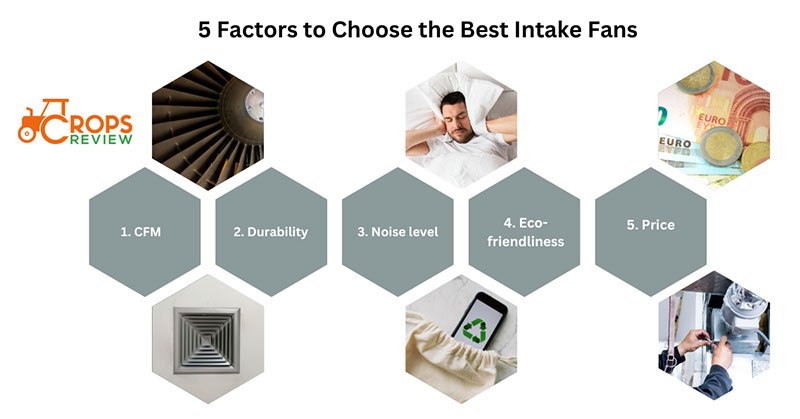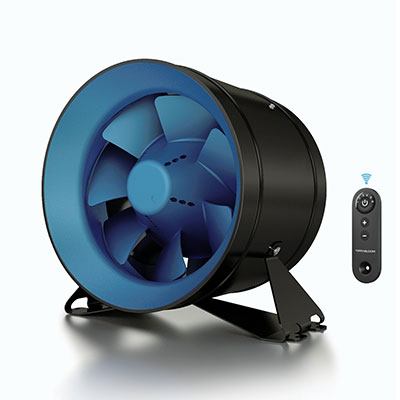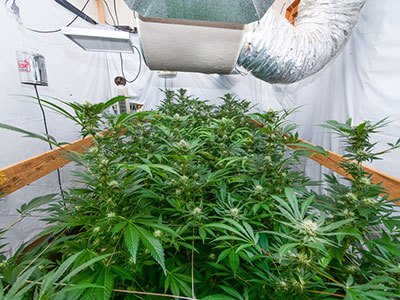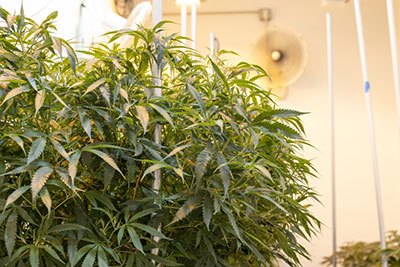An intake fan is a device that draws in fresh, cooler air from outside into a space like a grow room, computer case, or HVAC system.
An intake fan for grow tents creates a flow of air that helps regulate temperature and improve ventilation. When the fan is switched on, it pulls in cooler, fresh air from outside and circulates it within the space.
The intake fan improves air circulation, boosts plant growth in a grow room or cools down components in a computer, helps regulate temperature and humidity, and brings in fresh air, reducing the concentration of pollutants. But, without proper filtration, an intake fan brings in dust, dirt, and similar particles. If not properly balanced with exhaust fans, it creates positive pressure, leading to inefficient ventilation.
An intake fan is important when there’s a need for temperature control, improved ventilation, or a fresh air supply. It’s unnecessary in open spaces with natural ventilation or in climates where the outdoor air is too hot, cold, or polluted.
When choosing the best intake duct fan for a grow tent, consider the size of your space, the volume of air that needs to be circulated, and the temperature and humidity levels you want to achieve. The most important factor is its CFM rating, which indicates the volume of air the fan can move. Also, ensure it has a good filter to prevent dust and other particles from entering your space.
Table of Contents
- 1. AC Infinity CLOUDLINE PRO T6, Quiet 6″ Inline Duct Fan – Best controlling features
- 2. TerraBloom 4 Inch Inline Fan – Best safety standards
- 3. AC Infinity RAXIAL S6, Inline Booster Duct Fan – Best for secure lock system
- 4. VEVOR Inline Duct Fan – Best energy-efficiency
- 5. VIVOSUN Inline Booster Duct Fan – Budget-friendly intake fan
- 6. iPower 6 Inch 300 CFM Ventilation Booster Fan – Powerful performance
- 7. HUGOOME Inline Duct Fan 4 Inch Vent Booster – Best for DIY operations
- How Do You Choose the Best Intake Fans for Grow Tent Ventilation?
1. AC Infinity CLOUDLINE PRO T6, Quiet 6″ Inline Duct Fan – Best controlling features
The AC Infinity inline duct fun suits indoor growers due to its quiet operation. The noise level of only 32 dB doesn’t cause any noise, and you can use it 24/7.
This inline duct fan is versatile due to its compact size and lightweight design, weighing around 7 pounds/ 3 kg, so you can install it in grow rooms, grow tents, hydroponics, AV closets, houses, etc.
Its flexible features include cooling, heating, grow cycles, timers, minimum speed, scheduling, etc., so you can adjust them for your growing plants, such as increased air flow to prevent overheating.
You can also connect this intake fan to your WiFi app, set automation, view climate data, and access advanced programs, including alarm notifications, Bluetooth connections, and level control.
Due to its pre-installed and simple design, you can mount it on the wall or floor. Its 7.9×12.6 x 8.4 inches size allows you to install it in smaller grow rooms, including 2×2 and 3×3 grow tents.
We rated the AC Infinity intake fan 5/5 due to its longer lifespan and precision readings. Its quality matches its price tag.
Pros: Pulse width modulated engine for a longer lifespan and less noise, ease of use, and quick setup
Cons: Package issues – missing hanging cables for installation
2. TerraBloom 4 Inch Inline Fan – Best safety standards
The TerraBloom intake fan for your grow tent provides durable protection for extended use. The coated steel housing protects the engine from accidents and harsh elements. It also resists rust and reduces maintenance even though you will use it for an extended time.
This intake fan has an IPX4 ingress protection rating, meaning it is waterproof, but only for splashes, so you should not keep it near any water pots or containers.
The TerraBloom HVAC duct fan is flexible in installation due to its compact structure, making it suitable for grow rooms, grow tents, and house applications. Its functions ensure various controls, such as creating negative pressure, taking fresh air, exhausting smoke and odors, or stimulating wind.
Built with dual jet blades and a brushless EC motor, the TerraBloom intake fan delivers 141 CFM airflow at 21 watts of maximum power consumption. So, it’s efficient at lower speeds, and there is no wasted electricity.
Thanks to its EC HVAC design, this intake fan offers speed adjustments from 0 to 100% and uses the included variable speed controller without disruptive noise.
We rated the TerraBloom intake fan at 4.5/5, mostly due to its wireless connection and remote controller application. Its price is quite cheap, given its quality.
Pros: Flexible controlling system, adjustable functions for more extended use
Cons: Customer support is not available
3. AC Infinity RAXIAL S6, Inline Booster Duct Fan – Best for secure lock system
The AC infinity RAXIAL intake fan offers variable fan speed controllers, allowing you to adjust the airflow for various applications, including grow tents, houses, kitchens, grow rooms, and hydroponics.
Thanks to its unibody die-cast construction without welded seams, the AC Infinity RAXIAL intake fan ensures smooth airflow and reduces vibration for less noise. You can reduce noise by the soft rotating knob and adjust the noise level to meet your standards. However, customers still complain about noise even though you can reduce the noise levels.
Its engine is powerful and long-lasting since it comes with lubricated bearings and durable steel blades. The motor design resists rust and corrosion but also prevents accidents and explosions due to its cooling effect. The average lifespan of this intake fan is 67,000 hours without any maintenance.
The AC Infinity RAXIAL grow tent intake fan is rated 4.5 out of 5 thanks to its quick setup and ease of use. Its price tag is also affordable for all users.
Pros: Security system keeps debris, dirt, and dust out; versatile and flexible commands
Cons: Customers complain about weaker CFM that given 265 CFM
4. VEVOR Inline Duct Fan – Best energy-efficiency
The Vevor Intake fan offers universal applications, including exhausting humidity, smoke, and heat, improving airflow in grow tents and grow rooms, hydrophilic planting rooms, basements, kitchens, etc.
Due to its 807 CFM, you can install it in a larger grow room, a 4×4, or even a 6×6 grow tent.
Thanks to the 30% less energy consumption than other fans available on the market, such as Biggun or Hugoome inline fans. The Vevor intake grows tent fan offers enough power for reduced bills.
It also offers a level nose of 39 db, and it’s considered quiet. However, you can always adjust the noise settings and the motor to meet your needs. For instance, if your intake fan operates at 50 dB and 800 CFM, you can reduce the power to 600 CFM, and the noise level will be reduced to 37,5 dB.
The Vevor intake fan offers flexible commands. You can choose among high temperature, low temperature, high humidity, and low humidity options, as it adapts to a smart controller. You can turn the auto mode off when simultaneously pressing the up and down button.
Its auto alarm function is also included, and the controller starts or stops according to the temperature and humidity levels.
We rated the Vevor Intake fan at 4.5/5 due to its ease of use and flexible commands. The price is a bit higher, but you can use the auto-mode for growth control and observe the growing process on your phone.
Pros: Accurate readings, flexible to use and install
Cons: Requires manual speed adjustments
5. VIVOSUN Inline Booster Duct Fan – Budget-friendly intake fan
The Vivosun intake fan for a grow tent is an excellent option when you need a durable and reliable product. This intake fan requires no maintenance due to a permanently lubricated bearing and the high-quality steel housing. So it’s durable and reliable for a long lifespan of up to 5 years.
It also features a variable speed controller on the power cord.
Due to its small dimensions, 5.9″ D x 5.9″ W x 7.2″ H, the intake fan is compact enough to install in smaller grow rooms, such as 2×2 or 2×4 tents. Its diameter is six inches, with 275 CFM airflow and 3129 RPM.
The Vivosun intake fan for a grow tent works with less than 35 dB of noise level, so it won’t affect your sleep when using it at night. Its centrifugal impeller ensures quieter operations and longer life.
Due to its compact design, you can use it in grow rooms, grow tents, hydrophobic systems, house applications, etc.
We rated the Vivosun intake fan at 4.5/5 due to its compact design and ease of use. Its average price tag is affordable, so everyone can buy it.
Pros: Durable system to last longer, energy-efficient to reduce costs
Cons: The power wire easily breaks from the soldering
6. iPower 6 Inch 300 CFM Ventilation Booster Fan – Powerful performance
The iPower intake fan for a grow tent provides effective ventilation with 300 CFM and 2350 RPM, so it’s ideal for smaller and larger tents (2×2, 3×3, 4×4, 6×6 tents).
Due to its versatile design, the grow tent intake fan is great for grow rooms, hydroponics, grow tents, kitchens, garages, attics, houses, and basements.
Its motor lasts longer, up to 5 years, due to its durable design, which is made of reinforced plastic and powder-coated finishing, so the engine cannot rust or corrode so soon, even if you use it 24/7.
The iPower intake fan has a reduced noise level of 31 dB due to its deflector, which reduces the turbulence energy. Still, you can change the noise settings to match your needs by hanging your intake fan on the eye hooks on the stand, as the vibration will be lost in the ratchet straps or chain, or you can reduce the RPM for less noise.
It’s lightweight, compact, and offers a quick setup. The iPower flanges on the exhaust end and intake are easy to connect, making its setup effortless.
It’s rated 4.5/5 by our reviewers due to its quiet performance.
Pros: Compact and versatile, durable and sturdy
Cons: Poor customer support
7. HUGOOME Inline Duct Fan 4 Inch Vent Booster – Best for DIY operations
The Hugoome intake fan is an excellent product if you like DIY systems. This fan offers a 4-inch size, voltage power of 120V, rated power of 12W, and rated frequency of 60Hz. So if you have power cords and an electric system matching these standards, you can create your ventilation system easily.
Thanks to its speed of 2400 RPM and air volume of 76 CFM, the Hugoome intake fan covers homes, offices, grow tents, grow rooms, hydroponics, houses, restaurants, etc.
The intake fan lasts over three years due to its ABS shell material.
This motor has automatized safety standards, including disconnecting contact points without overheating to prevent accidents and damage. It also has a built-in temperature device for low heat generation to prevent plant burns.
The installation is quick, as the intake fan uses a 39-inch long power cord and plug-and-play system. The fan also offers brown and blue wires for the setup, as you can connect them according to the instruction manual.
We rated the Hugoome intake fan at 4/5 as it offers ease of use and convenience for indoor growers with DIY systems. Its price is also cheap, and its average quality suits the price.
Pros: Affordable, suitable for DIY growers, long lifespan
Cons: Not so strong; the blade breaks the spindle due to pressure
How Do You Choose the Best Intake Fans for Grow Tent Ventilation?
To choose the best intake fans for a grow tent ventilation, consider factors such as CFM, durability, noise level, eco-friendliness, and price.

CFM: CFM determines the fan’s effectiveness, maintaining the correct temperature and humidity levels. The ideal CFM depends on the size of your tent. Generally, your fan should be able to exchange the air in your tent at least once every three minutes. Therefore, divide the volume of your tent (in cubic feet) by three to find the minimum CFM you need. If you have an 8 x 4 x 12 feet grow room, this is 384 cubic feet of grow space, and when you divide it by three, you need 128 CFM of the fan.
Durability: Since your intake fan will likely run continuously, it must be durable enough to withstand this constant usage without breaking down. Please pay attention to fans made of high-quality materials such as steel or aluminum as they prevent rust and corrosion, offering solid construction to last for an extended period, usually over three years.
Noise level: A noisy fan can be distracting and disruptive, especially if your grow tent is located in a living area. Consider fans with a noise level of less than 50 dB for a quieter operation.
Eco-friendliness: This feature leads to less electricity, saving you money in the long run. Search for fans that are Energy Star certified or have other eco-friendly credentials.
Price: It’s important to find a fan that fits within your budget but also meets your other criteria, including quality, strength, performance, and power. Remember that you often get what you pay for. A cheap fan might not last as long or perform as well as a more expensive model. The prices range from less than $20 to more than $200, so check the quality first and then the price.
Active vs. passive ventilation: What are the differences?

Passive and active air intake systems are two methods of air ventilation used in indoor gardening.
Passive intake uses natural air flow and doesn’t rely on mechanical devices. It works by having a larger exhaust hole at the top of your grow tent and a smaller intake hole at the bottom. The exhaust fan pulls hot air out from the top, and cool fresh air naturally enters from the intake hole due to the pressure difference.
There’s no need for additional fans for the passive intake system. Since there are no mechanical parts involved, the system operates silently. However, you have less control over the amount and speed of airflow. Passive intake might not provide enough fresh air in larger grow rooms or tents.
Active intake involves actively using an intake fan to pull fresh air into the grow room. The fan is usually placed near the bottom of the tent to bring in cooler air.
You can control the amount of fresh air brought into the room by adjusting the fan speed. Active intake brings in sufficient fresh air even in larger grow spaces. However, it requires the purchase of additional equipment (intake fans). Fans produce noise, which may be disruptive.
Are intake fans necessary for a grow tent?
Intake fans are necessary for larger growing scenarios such as larger grow tents (6×6, 8×8, 10×10) where passive intake might not be sufficient or if you plan to grow more plants. For example, a 10×10 tent allows 32 medium plants, such as cannabis, requiring additional fans to prevent overheating.
However, they are unnecessary in small, personal grow tents where the passive intake meets the ventilation requirements. Also, passive intake might be a more suitable option in environments where noise is a concern, like residential areas.
When should you not use intake fans in indoor growing?
You should not use intake fans when they do not have filters, as there is a risk of contaminants like pests, dust, and mold spores. In such cases, it might be better to control the intake passively to reduce this risk.
You don’t have to use intake fans if you’re on a tight budget. Active air exchange systems require additional equipment, which means additional cost, so starting with a passive system is more cost-effective.
If your indoor garden is in a larger room with an HVAC system that already controls temperature and humidity effectively, you might not need an additional intake fan.
What are the differences between air intake and extractor fans?

The main differences between the air intake and extractor fans include their function, placement, and size.
Air intake fans pull fresh air into a space and draw in cooler air, regulating temperature and providing carbon dioxide for the plants.
Extractor (exhaust) fans expel hot, stale, and humid air out of the grow tent or room, controlling heat and humidity levels.
Air intake fans are typically placed lower in the grow room or tent because cooler air tends to be lower to the ground.
Exhaust fans are usually situated at the top of the grow room or tent since hot air rises.
The best inline duct fan is often slightly smaller than exhaust fans. It maintains negative pressure within the grow room or tent, which aids in odor control and ensures that all air being pulled in is also being effectively expelled.
Can I use an exhaust fan like an intake fan?
It’s possible to use an exhaust fan as an intake fan, but it may not be the most efficient option. The difference in their size affects the performance, as exhaust fans maintain negative pressure in the room. If you use an exhaust fan (which is usually larger) as an intake fan, it might disrupt this balance and create positive pressure instead.
Using an exhaust fine as an intake fan will change the airflow direction and negatively affect its performance.
Exhaust fans often don’t have filters because they’re expelling air out of the room. When used for intake, it’s recommended to add a filter to prevent dust and other particles from entering the grow space.
What size intake fan for a grow tent/room?
The intake fan size for a grow tent is determined by several factors, including the size of the space and the amount of heat generated by your lights. The intake fan size for the grow tent should be slightly smaller than the exhaust fan to maintain negative pressure in the grow room. If you have an 8″ exhaust fan, a 6″ intake fan would be ideal.
For instance, if you have a 4×4 grow tent with a height of 6.667 ft, the total volume is approximately 106.67 cubic feet, so you need at least 106 CFM of the intake fan.
If you’re growing in a larger space, such as a 10′ x 10′ room with 8-foot ceilings, your cubic footage would add up to 800 cf. In this case, you need two 6-inch fans with 402 CFM.

How do you set up an intake duct fan?
To set up the intake duct fan, disconnect power to the area where you’ll work. Attach your inline fan to the extra ceiling bars that your grow tent most likely came with. Adjustable rope clip handles can be used to hang the fan.
Connect the fan to the ducting that leads outside your grow tent or room. Ensure all connections are secure to prevent air leaks.
Place the backdraft damper in front of the inline fan. When the fan is turned on, the backdraft damper opens, allowing air to flow in one direction and preventing it from flowing back.
Once everything is installed, turn on the system to ensure it works correctly. The intake fan should pull fresh air into the grow tent, and the exhaust fan should expel hot air out.
How long should you have your air intake fan on?
Your intake fan should be on for 15 minutes and off for 45 minutes in the hourly pattern.







